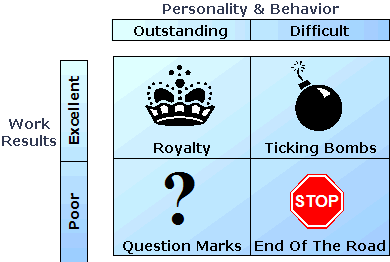Results matter. But how your wellness coaches, trainers, yoga instructors and managers get results — their personality and behavior — matters more. Here’s our guide to the four types of employees — and do’s and don’ts for getting the best from them.
Royalty
Picture your fitness director. She’s rolling out new programs, handling customer issues, recruiting great staff. You’d clone her in a heartbeat. Great attitude and work ethic, sharp and productive. She sees challenge and opportunity where others see obstacles.
Business risk: You’ll lose them if they feel underappreciated, taken advantage of, or bored.
Common mistakes: Taking them for granted. Ignoring their interest in career growth and learning new things. Failing to honor their efforts and express appreciation for their accomplishments.
The approach: Treat them like…well…royalty! Good performers want positive and specific feedback about what they’re doing well. They often want new challenges. While pay matters, “soft rewards” work too — public praise and unexpected pats on the back like extra paid vacation or a fruit basket delivered to their home with an appreciative note.
Ticking Bombs
This is the personal trainer who has good rapport with the clients he likes — but rushes the clients he doesn’t enjoy, treats the front desk staff like peasants, ignores club policies and standards, leaves the “dirty work” for everyone else. Some clients love him — but he leaves a trail of broken glass: hurt feelings from other staff, upset clients, and wastes your time smoothing ruffled feathers.
Business risk: Failure to address the issues, either because you’re afraid he’ll take the clients and go, or because you cringe at the thought of an argument with him. Gives other staff the impression that this person is untouchable. Suggests this kind of behavior is completely acceptable. Demotivates good performers who have to put up with it.
Common mistakes: Ignoring the “broken glass”. Or discussing it repeatedly with the problem employee, but allowing it to continue uncorrected for a long time.
The approach: People like this cost far more than the value of their work.
Do the math:
- Optimistically, say you spend only 30 minutes/week dealing with the problems created by this person. That’s three days a year! In reality, you probably spend far more time thinking about the situation and intervening to smooth things over, plus counseling the problem employee.
- Consider the impact on your personal life. Is this your first topic of conversation at home?
- Add the lost productivity of staff distracted by this person. Often it’s their first topic of conversation at home, too!
- Recruiting and training to replace staff who leave because they’re sick of dealing with this guy.
- Negative word-of-mouth from unhappy staff and ticked off customers.
Imagine what you could be doing with three or more extra days…Imagine how much happier and productive everyone else will be if they’re not furious after every interaction with this guy.
Our experience is that people like this rarely change problem behaviors. So as a manager, you need to quickly get a performance improvement plan in place so that the individual either rapidly improves, or rapidly leaves the company. You mustn’t let it drag on indefinitely.
Specifically:
- Begin by clearly describing the inappropriate behavior.
- Give examples of the appropriate behavior.
- Then ask them how they plan to improve.
- Have them write down a specific action plan with dates.
- Let them know that you’ll get feedback on their progress from colleagues.
- Monitor progress against the action plan.
- If you don’t see consistent and prompt progress, move through progressive discipline to termination, generally in no more than 30 days.
This kind of discussion is really tough for most managers. Rehearse so that you can confidently address the employee. Role-play with a trusted advisor. Or give us an hour or two of your time and we’ll help you get ready.
If this person is in a key role, start identifying possible replacements before you initiate the performance discussion. The odds are high that you’re going to end up replacing him sooner rather than later.
Question marks
Picture one of the nutritionists or dietitians that works at your corporate wellness company . She’s super-enthusiastic and knows a lot about nutrition. But her client skills are terrible. Clients complain that she acts like the “food police”. They leave her presentations confused by the technical jargon. Yet she energetically tackles any project you give her.
Or perhaps you’ve got a very personable yoga instructor who’s great with special populations — very empathetic and extremely knowledgeable, and gets along great with the other employees. But he’s frequently late for sessions and staff meetings. You’re constantly taking personal messages for him during the work day. And although he always sounds eager to tackle new projects, not much really happens without your hands-on involvement.
Sometimes people just don’t have the skills or experience for the job they’re in. Sometimes they have the capabilities, but personal matters distract them.
Business risk: Your business needs results from this employee. If they don’t deliver, you or other staff start doing some of their work. Good employees feel put upon and taken advantage of. The company is paying for results it’s not actually getting.
Common mistakes: Dawdling on addressing performance issues while you and other employees pick up the slack and correct this person’s mistakes.
The approach: Begin by assessing whether this is a knowledge issue, a time management issue, or a boundary issue.
If it’s knowledge:
- Identify the missing skills.
- Assess how quickly these skills can be learned and at what cost to the business.
- Decide whether you can wait for that to happen.
- Keep in mind that unless you’re paying a “learning wage”, they’ll need to get up to speed very quickly or you’re wasting money by paying them more than the results you’re getting are worth.
If it’s time management:
- You’ll need to play “time management” teacher.
- Provide hands-on help in developing prioritization and planning skills.
- We don’t usually recommend time management classes. Hands-on guidance from someone in the business seems to produce better results.
- Ultimately, hold them accountable for developing the ability to plan their work. Don’t let your teaching role slide into “upwards delegation” to you.
If personal issues cross the boundary into work performance:
- Make it clear that their performance must meet the needs of the business.
- For historically strong performers who have hit a rough patch, you may be willing to make accommodations — for example, a flexible schedule.
- However, if their performance has never been particularly strong, fire them and find someone who’ll truly make a difference.
End of the road
This is the health club billing manager who’s rude to staff and customers, error-prone, and blames everyone else when things go wrong. Lousy attitude, difficult or high-maintenance temperament, mediocre to poor work.
Remember that first and foremost, businesses pay everyone to produce results. Poor results + poor attitude = wasted money and time. Tolerate them and demoralize good employees and alienate customers.
Business risk: Most importantly, the business needs results from this employee or their position wouldn’t even exist, right? So the company is paying for results it’s not getting. Plus, like all staff issues, failing to address this drags down good employees. It’s usually apparent to customers as well.
Common mistakes: Avoiding an often difficult termination discussion with the employee, resulting in prolonged tolerance of clearly bad performance.
The approach: Take prompt action to protect your business and resolve the performance issue.
- Begin identifying possible replacements.
- Document the performance shortfalls.
- Meet with the employee and explain the difference between your expectations and their performance.
- Tell them that you expect immediate improvement.
- Have them write a specific performance improvement plan.
- Follow up within a week to monitor progress against the plan.
- If they don’t show prompt and consistent progress, quickly move through progressive discipline to termination.
One final note
When handling difficult employee situations, the Family And Medical Leave Act (FMLA) and the Americans With Disabilities Act (ADA) may apply, as well as other state and federal laws. Consult your company’s employment attorney for legal guidance.





